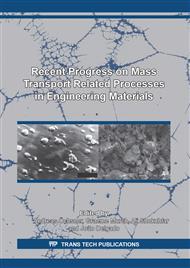p.123
p.135
p.146
p.152
p.159
p.170
p.176
p.186
p.193
Grain Structure and Electrical Properties of Transparent Indium Oxide Thin Films Prepared by RF Magnetron Sputtering
Abstract:
Transparent conductive films of indium oxide (In2O3) are deposited on a glass substrate by RF magnetron sputtering and their electrical properties are investigated in relation to their microstructure. Sputtering deposition was carried out with variations of normalized substrate temperature (Ts/Tm where Tm is the melting temperature) and argon partial pressure (PAr). At a very low substrate temperature (Ts/Tm < 0.1), the columnar grains with voided grain boundaries are observed in the In2O3 films, which are attributed to the low surface mobility and atomic shadowing effect. With an increase in the substrate temperature, tight grain boundaries are formed between the growing columnar grains. At high temperature (0.3 < Ts/Tm < 0.5), the grain surface is faceted, which is due to the high surface mobility of the sputtered atoms, and development of preferred orientation with grain growth is promoted. The growing morphology is also dependent on the argon partial pressure. At low PAr deposition, an inclined fibrous grain oriented to the target direction and a smooth surface structure is developed. As the PAr increases, a dome-shaped surface structure and columnar grains normal to the substrate are developed due to the scattering effect of the sputtered atoms. The growing morphology with substrate temperature and argon pressure coincides with the Thornton's Structure Zone Model (SZM). The lowest electrical resistivity (2.1×10-2 Ωcm) is observed in the In2O3 films with tight grain boundaries and faceted grains, which corresponds to zone II region of the SZM.
Info:
Periodical:
Pages:
170-175
Citation:
Online since:
March 2020
Authors:
Price:
Сopyright:
© 2020 Trans Tech Publications Ltd. All Rights Reserved
Share:
Citation:


